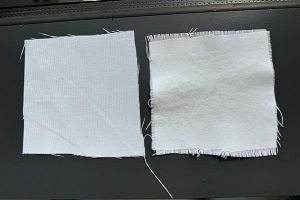Reviewed by Lexie CornerAug 23 2024
Scientists at the University of Massachusetts Amherst have developed a durable chalk-based coating that can reduce the temperature of the air beneath treated fabric by up to 8 ºF.
 A chalk-based coating attaches to various commercially available textiles, including cotton and synthetic fiber, to create cooling fabrics, such as the treated synthetic material (right) that’s brighter than the untreated fabric (left). Image Credit: Evan D. Patamia
A chalk-based coating attaches to various commercially available textiles, including cotton and synthetic fiber, to create cooling fabrics, such as the treated synthetic material (right) that’s brighter than the untreated fabric (left). Image Credit: Evan D. Patamia
A cooling fabric could benefit anyone spending time outdoors in the intense summer heat, such as athletes, landscapers, children at the park, and beachgoers. While some textiles can reflect sunlight or dissipate body heat, current materials often require specialized fibers or complex manufacturing processes.
Evan D. Patamia, a graduate student at the University of Massachusetts Amherst, will present this research at the American Chemical Society's (ACS) fall meeting.
If you walk out into the sunlight, you will get increasingly hot because your body and clothing are absorbing ultraviolet (UV) and near-infrared (near-IR) light from the sun. And as long as you’re alive, your body is generating heat, which can be thought of as light, too.
Trisha L. Andrew, Chemist and Materials Scientist, University of Massachusetts Amherst
Andrew collaborates with Patamia on this research.
Scientists have been developing textiles that enhance outdoor comfort by reflecting solar radiation and releasing body heat, a process known as radiative cooling. Some of these materials use spun fibers containing artificial particles like aluminum oxide or titanium dioxide to reflect light. Others employ organic polymers, such as polyvinylidene difluoride, to create light-reflective fabrics. However, the production of these materials often requires perfluoroalkyl and poly-fluoroalkyl substances (PFAS), also known as "forever chemicals."
However, Andrew notes that scaling up the production of these materials for commercialization is not feasible.
Andrew then asked Patamia and Megan K. Yee, who are on the research team, the question, “Can we develop a textile coating that does the same thing using natural or environmentally benign materials?”
Previously, Andrew and his colleagues developed a simple method called chemical vapor deposition (CVD) to apply durable polymer coatings on fabric. This technique involves grafting a thin polymer layer onto commercial textiles in a single step, combining synthesis and deposition, which reduces environmental impact compared to other coating methods.
Inspired by the use of crushed limestone-based plasters historically employed to maintain house temperatures in sunny regions, Patamia and Yee aimed to incorporate biocompatible barium sulfate and calcium carbonate into the polymer applied via CVD. Barium sulfate particles are effective at reflecting UV light, while small calcium carbonate particles are good at reflecting visible and near-IR wavelengths.
The researchers treated small squares of fabric with a 5 µm thick layer of poly(2-hydroxyethyl acrylate). They then repeatedly dipped the polymer-treated squares into solutions containing calcium or barium ions along with carbonate or sulfate. As the crystals grew larger and more uniform with each dip, the fabric acquired a chalky, matte finish. Patamia noted that by varying the number of dipping cycles, the particle sizes could be optimized to fall within the 1 to 10 µm diameter range, ideal for reflecting both UV and near-IR light.
On a sunny day with outdoor temperatures exceeding 90 ℉, the researchers tested the cooling properties of the treated versus untreated fabrics. In the middle of the afternoon, they observed that the air temperatures beneath the treated fabric were 8 ºF cooler than the surrounding air temperature. The difference between the treated and untreated fabrics was even more significant, with the air beneath the untreated fabric being up to 15 ℉ warmer.
We see a true cooling effect. What is underneath the sample feels colder than standing in the shade.
Evan D. Patamia, Graduate Student, University of Massachusetts Amherst
Yee conducted a simulation to evaluate the durability of the mineral-polymer coating by mimicking the friction and effects of laundry detergent in a washing machine. The results showed that the coating remained intact, and the material's cooling properties were preserved even after washing.
So far in our processes, we’ve been limited by the size of our laboratory equipment.
Trisha L. Andrew, Chemist and Materials Scientist, University of Massachusetts Amherst
Trisha L. Andrew is part of a startup company that is scaling the CVD process for bolts of fabric, which are about 5 feet wide and 100 yards long. Andrew explains that this venture could provide a way to translate Patamia and Yee’s innovations into pilot-scale production.
Patamia concluded, “What makes our technique unique is that we can do this on nearly any commercially available fabric and turn it into something that can keep people cool. Without any power input, we’re able to reduce how hot a person feels, which could be a valuable resource where people are struggling to stay cool in extremely hot environments.”
The study was funded by the United States National Science Foundation. Trisha L. Andrew is working on bringing the polymer coating method to market.
Crystal coating keeps clothes feeling cool | Headline Science
Crystal coating keeps clothes feeling cool. Video Credit: American Chemical Society